If you’re missing a tooth or teeth, you’re not alone! Most adults are missing at least one tooth. (not counting wisdom teeth). If you’re not sure how to go about replacing your missing tooth and you’re not comfortable allowing your dentist to decide for you, keep reading!
Before diving into the subject of how we can replace missing teeth, first determine whether or not replacing your tooth or teeth is truly necessary. For guidance on that decision, click here.
Many factors come into play when deciding on the best tooth replacement option for you. They include
- what is clinically achievable
- your personal preferences
- your tolerance for dental work
- the time and money you’re willing and able to invest
To help you make the best decision for you, I’m going to review the pros and cons of each approach.
There are only three ways we can replace missing teeth:
1.) A removable partial denture
2.) A bridge
3.) An implant
Removable Partial Dentures
A removable partial denture (“partial”) is a custom fit, plastic, sometimes partly metal device with teeth on it. As long as you have sufficient healthy, natural teeth remaining you are a candidate for a partial.
There are two types of partials intended for long-term use and chewing:
- cast metal partial (the gold standard)
- flexible partial
Most people find that the flexible partial is more comfortable and aesthetically pleasing than the cast metal partial. But, it’s not quite as strong as the cast metal supported partial. You need healthy teeth on both the right and left sides of your jaw for either type of partial to work. But, the stronger cast metal partial can replace more missing teeth than the flexible partial.
A flexible partial also requires more space between your upper and lower teeth than the cast metal partial. It needs enough room to accommodate the thickness of the flexible material. My preference is to make flexible partials for those who are candidates. Otherwise, I will go with the tried-and-true cast metal partial.
Partial – Pros
The biggest advantage of a partial is the cost! It’s the least expensive choice. It will replace all of the missing teeth in a given jaw at one time – a nice one-and-done option. The dental work involved to make a partial is non-invasive.
No numbing or significant tooth shaving is required. Almost anyone is a candidate for a partial. The result is aesthetically pleasing – the replacement teeth look quite natural. Often patients will start with a partial and work towards a non-removable tooth replacement solution in the future.
Partial – Cons
Some people are psychologically bothered by the idea of wearing something removable in their mouth. They remember seeing grandpa’s teeth in the bathroom! It may conjure up negative associations with aging. But, truth be known, people of all ages and from all walks of life wear partials. It’s more common than you may think.
Wearing something in your mouth all day long and eating with it can be tough to get used to. It’s never the same as natural teeth. Different folks have different tolerances to this change. We strive to get the best fit possible, but even with our best efforts, you may struggle from time to time with sore spots. Some people have a super strong gag reflex which makes wearing anything in their mouth very difficult.
Patients must be motivated to go through the effort to get used to it. For that reason, it’s not a great option if you’re replacing just one or two back teeth. Most people will not find that sufficiently motivating to go through the effort to adapt to it. It will end up collecting dust in your bathroom drawer. But, if the partial will help you chew, and/or replaces teeth in your smile line, most people will successfully adapt to it in time. It just takes patience.
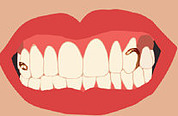
Depending on which teeth you are replacing and the type of partial you get, you may see metal clasps when you smile. The sight of these clasps is objectionable to some people. There are ways around it but could make the partial more expensive, or less durable.
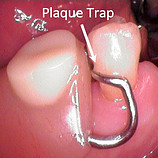
A partial can present hygiene challenges. A lot of plaque can accumulate around these natural tooth interfaces, such as clasped areas. Plaque causes both cavities and gum disease, which are the most common reasons for missing teeth.
To prevent your remaining natural teeth from succumbing to the same dental disease that claimed your missing teeth, exceptional home care is required, as well as regular visits to your dental hygienist.
Even if all of your remaining teeth stay healthy, a removable partial denture should be replaced about every seven years. Toothless areas lose bone over time. We want an ideal fit to keep the pressure as even as possible to prevent unnecessary wear and tear on your natural teeth and your bone.
Final Note about Partials
If you do elect to get a removable partial denture and you intend to wear it for more than a year, it’s important to be sure your remaining natural teeth are healthy and structurally sound before we make your partial. That means you need to get any needed fillings and crowns done before having your partial fabricated. Long term partials are made of materials that we cannot easily adjust to accommodate new dental work.
If you need a temporary tooth replacement for aesthetic reasons while you’re undergoing your more definitive dental work, you can get the cheapest type of partial called a “flipper.” A flipper is designed for very short-term use, and it’s only for smiling, not chewing. But, it will prevent the social discomfort of missing front teeth while you’re undergoing care.
Once your remaining teeth are in good shape, you can get the more durable, longer lasting partial that is designed for both smiling and chewing.
Bridge
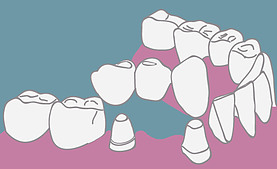
Fabricating a bridge consists of placing crowns on anchor teeth and attached to those crowns are the fake tooth or teeth that we are replacing.
Bridge – Pros
Their main upside is that they are not removable. They are cemented in place; they feel natural and look nice. They are often less expensive than dental implants. And, the process to complete the bridge is usually very fast compared to partials and implants.
For those who do not want to wear a removable appliance and are not candidates for a dental implant, a bridge might be the best choice.
Bridge – Cons
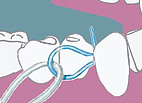
Hygiene can be a little more difficult. You can’t floss between the teeth in the area of the bridge. You’ll have to thread the floss underneath or use another hygiene aid like a proxy brush to keep the area clean.
To make a bridge, we have to shave down the anchor teeth (or “abutments”). That’s usually not something we want to do.
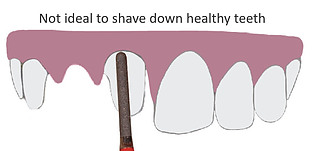
The one exception would be if the anchor teeth would have benefitted from getting crowns anyway. In these cases, it might make the most sense to do a bridge. You’ll get both the needed crowns on the anchor teeth and attach the missing tooth while you’re at it. Even though an implant may be the ideal choice, a bridge can be a reasonable compromise.
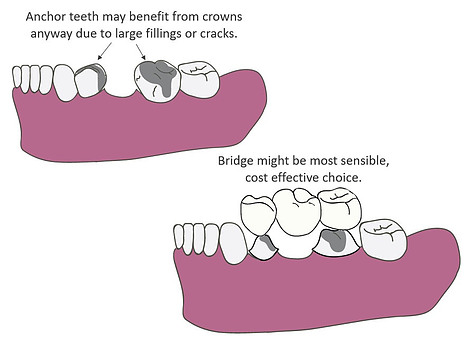
Bridges don’t last forever. Ten years seems to be a typical lifespan. That said, the lifespan can vary significantly from person to person. Some people have had a successful bridge for over 30 years. There are variables to bridge longevity that are beyond a dentist’s control. They include:
- The quality of patient’s home care
- Susceptibility to dental diseases like cavities and gum disease
- Habits like smoking
- Frequency of dental checkups and compliance with provider recommendations
- Losing other teeth that increase the intensity of chewing forces on the bridge
Those factors will dramatically influence the lifespan of a bridge.

There are limited candidates for a traditional bridge restoration. You need quality anchor teeth on each side. When you chew on the replacement teeth, the anchor teeth are absorbing these forces and they need to be strong enough to handle them.
Anchor teeth must have good bone support and be structurally secure. Teeth with root canals are less pliable, and not ideal. It does not necessarily preclude them from the job of an anchor tooth, but it is a consideration. If the anchor tooth has tilted too much, preparing it for a bridge may not be feasible.
You also don’t want to overload your anchor teeth with too many replacement teeth. The dental rule is that the root surface area of the anchor teeth cannot be less than the theoretical root surface area of the replaced teeth. (It’s called “Antes Law”). You can use more than two anchor teeth, but this makes the bridge that much more invasive and expensive.
Bridge Variations
Maryland Bridge
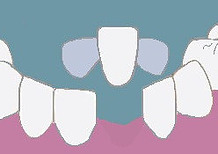
A “Maryland” bridge is a variation on a bridge where we can be much more conservative. We don’t need to prepare the anchor teeth for full coverage crowns. Instead, we just prepare smaller notches on the anchor teeth to bond metal wings. They are much less expensive than traditional bridges.
The Maryland bridge can work to replace teeth that don’t experience heavy chewing forces – most commonly lower incisors or upper lateral incisors. But, since there is much less bonding surface area, these restorations are prone to de-bonding.
Cantilever Bridge
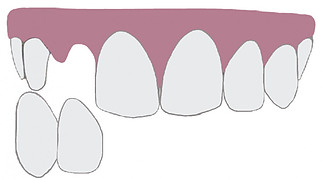
A “cantilever” bridge has an anchor tooth on only one side. Fewer crowned anchor teeth make the restoration less expensive and less invasive, but a cantilever bridge can only be done in very limited circumstances. Again, every time you chew on the fake tooth it will put force on the anchor (abutment) tooth.
In this case, the bridge is only stabilized on one side so the force will be like a seesaw. For that reason, I would only do a cantilever bridge to replace an upper lateral incisor and use the strong, long-rooted upper canine as the anchor. It is just too risky anywhere else.
The success of your bridge relies on the health of the natural anchor teeth. Placing crowns on the anchor teeth does not mean they can’t get new cavities or develop gum disease. What makes me the most nervous about doing a bridge is the possibility that an anchor tooth will develop a new cavity, a root fracture, or succumb to gum disease.
If that happens, the whole bridge is toast! We have to drill the bridge off to fix the issue and start from square one. That’s painful news to deliver to a patient.
All that said, bridges have been done for many years. They still have a place in dentistry. A bridge can be a great option for the right circumstances.
Dental Implant

A dental implant involves placing a fake root into the jaw bone, which is usually made of titanium. Then the fake root is used as a platform to build a crown onto it. More specifically, we screw an abutment onto our implant. Then, we cement or screw a crown onto this abutment. The dental implant technically only refers to the fake root, not the abutment or crown.
Dental Implant – Pros

It’s easy to see the many advantages of dental implants. They behave like natural teeth. You can floss between them. You don’t have to shave down the neighboring teeth. And, a dental implant restoration offers one nice upgrade from natural teeth – it won’t get a cavity! If your dental problems were caused mainly by cavities, an implant is an excellent choice.
Implants also preserve bone. It turns out that when your bone is no longer anchoring your tooth, it starts to resorb away. The dental implant prevents that.
Another advantage is that once the dental implant (the fake root) has successfully fused to the bone (“integrated”) it can last a lifetime. The crown on top may need to be replaced one day, but the dental implant itself will usually stick around for life.
Dental Implant – Cons
The process is invasive. In some cases, a gum flap surgery is required to place an implant into the bone. That said, post-operative discomfort is usually less than people expect. Another challenge is finding enough good bone. Implants must be surrounded by bone in every direction – 360 degrees around and all the way up and down.
In the upper jaw, often the sinus cavity gets in the way. In such a case, we have to add bone to the sinus before we can place the implant. Adding this “sinus lift” procedure to the mix makes it more costly, time-consuming, and invasive.
In the lower jaw, there is a very important nerve we must avoid. And our calculations may reveal that there is not enough bone above that nerve to place an implant. Other times the ridge is just too thin.
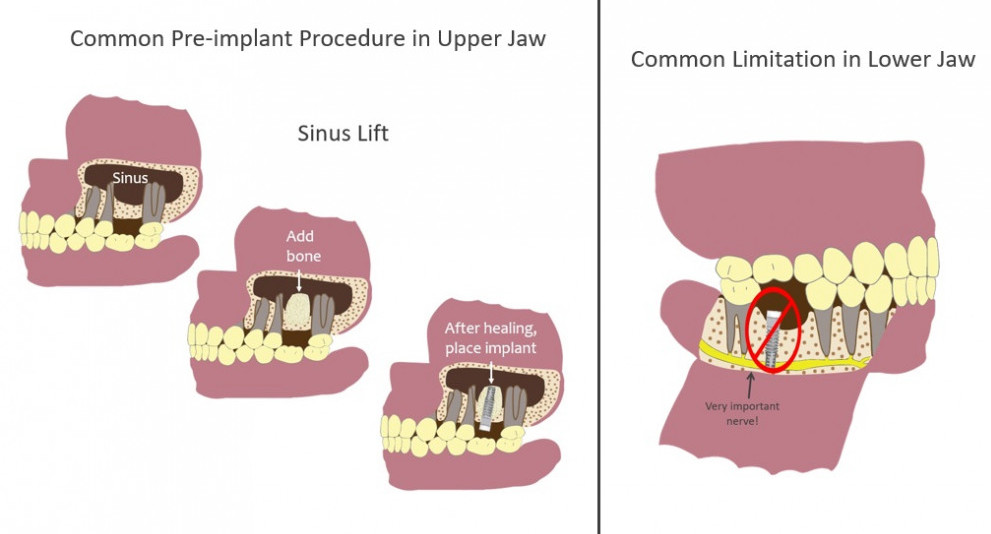
Fortunately, in many, many cases plenty of bone is available. We’ll figure that out with clinical measurements and an x-ray. Or in some cases, we will need a three-dimensional image called a cone beam scan.
In cases where not enough bone is available, we can often add it where it needs to be. Though, in the lower jaw, adding bone is a little more difficult and not always feasible.
Even if plenty of bone is available, you still may not be a candidate for an implant. Heavy smokers and those with certain medical conditions like uncontrolled diabetes have a high implant failure rate. We need to be sure that your bone is healthy enough for successful implant integration.
The implant process requires more healing time and patience than a partial or bridge. In most cases, you can’t put the crown on the implant the day it is placed. You have to wait a few weeks until the implant successfully integrates into the bone.
If bone augmentation is needed to prepare the site for implant placement, the whole process will take even longer. It can take many months from start to finish. Sometimes a removable appliance is used as a temporary tooth replacement while you’re waiting for your final crown.
Implants usually last a lifetime, but that’s not guaranteed. They can be subject to a disease called peri-implantitis just as natural teeth are subject to periodontitis. You must still practice good home care and regular visits to your dental hygienist. Even with your best efforts, peri-implantitis can still happen.
The biggest reason that most people decide against dental implants is the cost. There is one fee for the implant placement and another for the abutment and crown. And, that doesn’t include any bone augmentation procedures that may be needed before implant placement! Frustratingly, many dental insurance companies still don’t offer coverage for dental implants.
However, it’s worth considering not just the immediate cost of any dental restoration, but the lifetime cost. In most cases, the implant is there for life. You may need to replace the crown on top of the implant once or twice, but not the implant. On the other hand, if you lose and have to replace a three-unit bridge a few times throughout your life, that will add up!
Implant Variation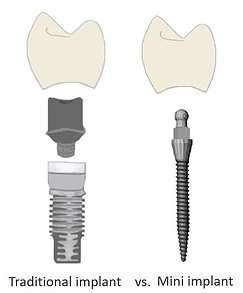
Traditional dental implants have been available since the 1960s. A newer variation has recently emerged called a Mini Dental implant. Mini implants are simply a narrower version of traditional dental implants (< 3mm wide).
They were developed to overcome some of the downsides of traditional dental implants. You don’t need as much bone to place them. The process is less invasive, and they are much less costly. They’re still somewhat controversial and they are not for everybody, but a mini implant restoration could be the right choice for the right candidate.
Despite all the challenges with dental implants, they are placed all the time! They are the best tooth replacement option currently available.
I hope this helps you make sense of the different ways we can replace your teeth, and gives you the background to make the decision that is best for you. If you have any thoughts or questions, please post them in the comments below!




Your articles are so important to read before going to a dentist. Thank you for informing us who read your articles and making them easy to understand. You are very good at breaking it down and making it easy to understand for us who are not in dentistry.
Thank you!
Thank you! Glad it helps. If you have any specific questions, feel free to email me directly at bethanndorian@gmail.com